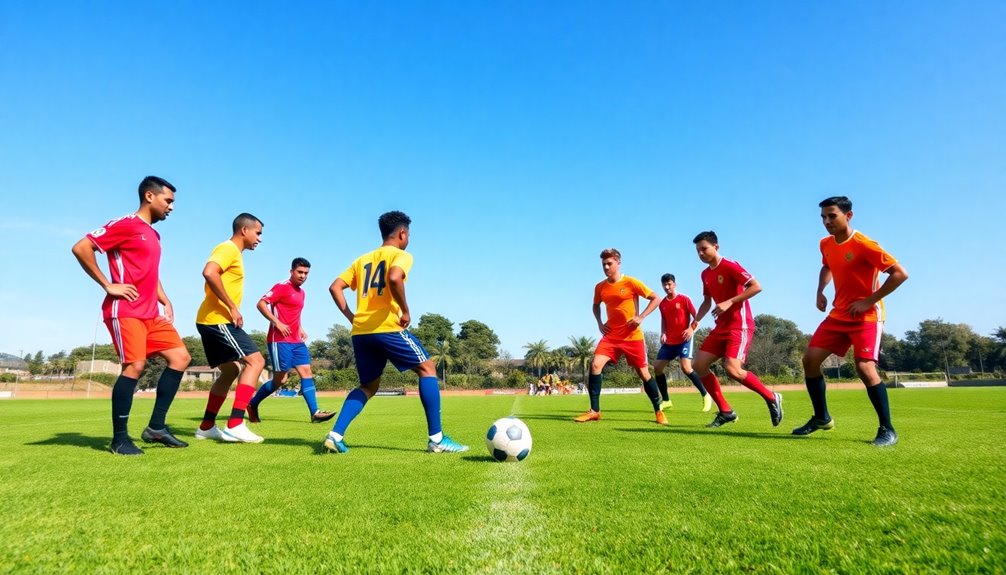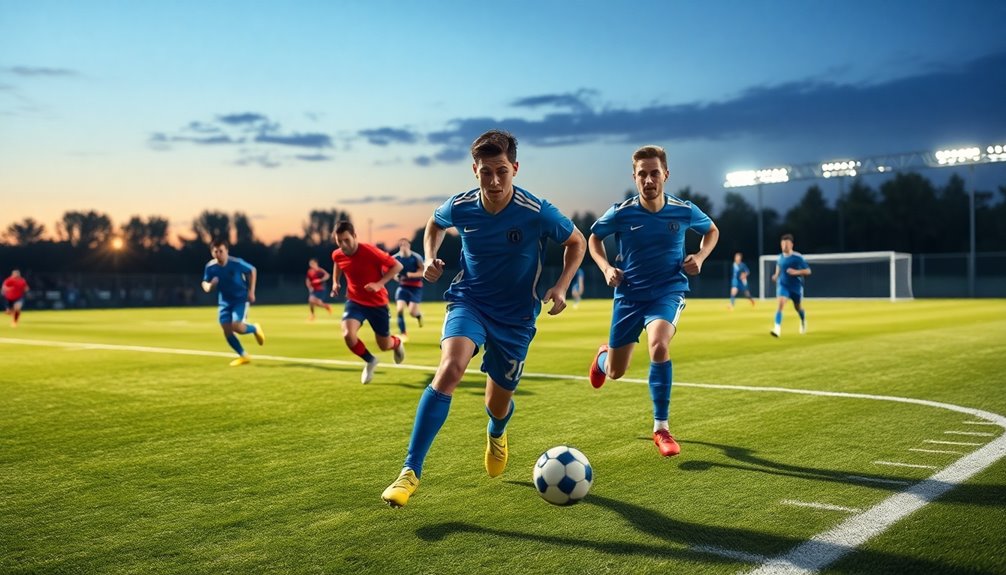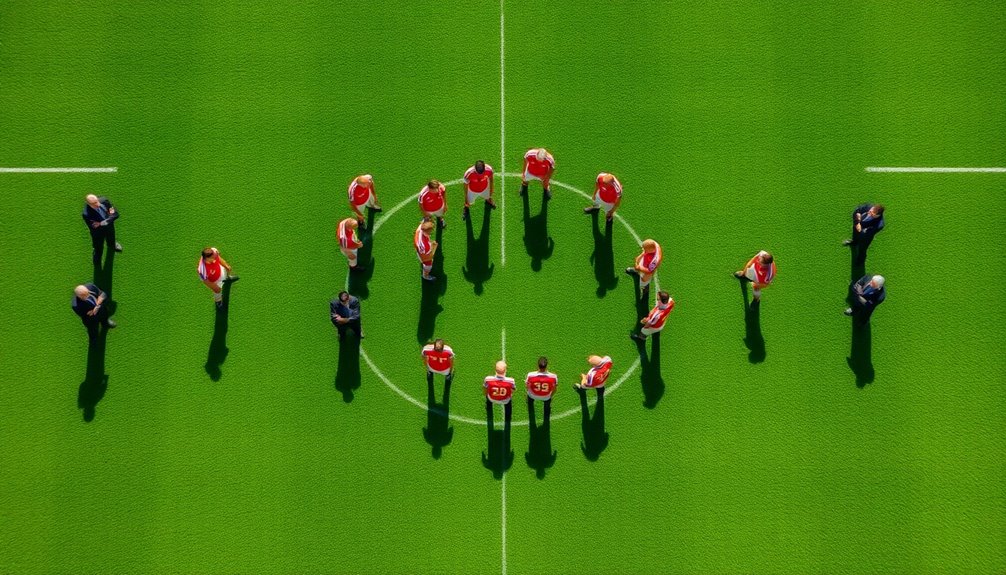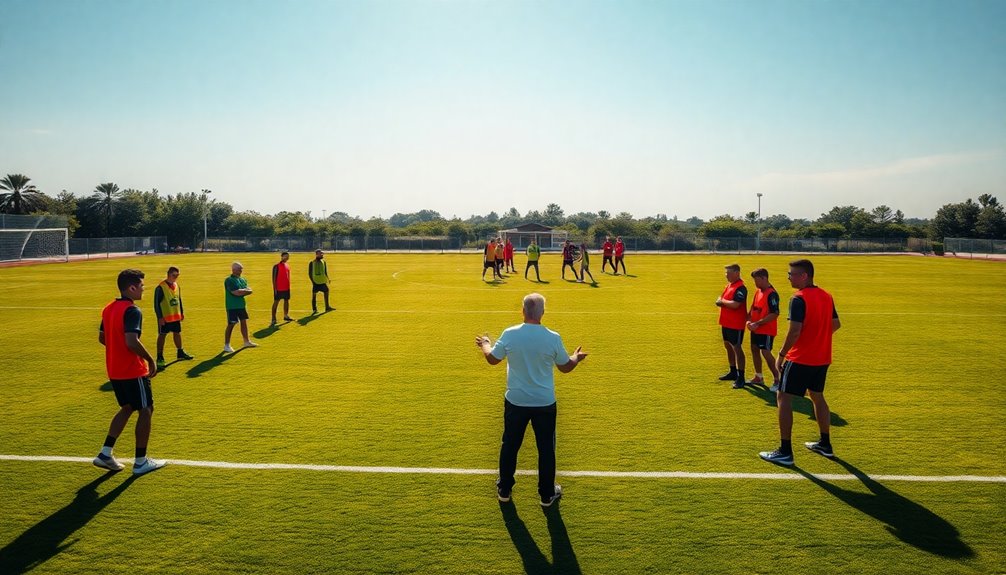
How to Implement the 3-2-3-2 Soccer Formation
March 16, 2025To implement the 3-2-3-2 soccer formation, prioritize organization and communication among your players. Set up a back three to guarantee solid defense, while your two defensive midfielders act as shields. Utilize wingbacks for width and support in attack, creating space for midfielders. Focus on quick shifts between defense and offense, maintaining tactical discipline. Emphasize roles and responsibilities during practice. You'll find even more effective strategies as you explore further into the formation's dynamics.
Understanding the 3-2-3-2 Formation
When you immerse yourself in the 3-2-3-2 formation, you'll find it offers a balanced approach that supports both defensive stability and offensive creativity. This setup features a back three, providing a solid defensive foundation while the two defensive midfielders shield them effectively. The three midfielders, including the Central Midfielders, enhance possession and control the game's tempo. Additionally, the formation's flexibility allows teams to adapt quickly to changing match dynamics, ensuring they can respond to opponent strategies effectively. This adaptability is similar to the 3-2-1 formation, which promotes player development and tactical awareness.
When altering from offense to defense, the offensive center midfielder can drop back, maintaining a compact formation that fortifies your defense. This flexibility allows you to shift into a 3-5-2 during attacking phases, disrupting opponents and clogging the center. To maximize effectiveness, players need stamina, communication skills, and the ability to switch roles quickly. Additionally, effective player selection is crucial for maintaining balance in formations and enhancing overall team performance.
Key Player Roles and Responsibilities
In the 3-2-3-2 formation, each player has specific roles that are crucial for the team's success. The goalkeeper organizes the back three defenders and guarantees clear communication. The goalkeeper's ability to make critical saves is essential for maintaining team morale and confidence.
Your center backs need to excel in one-on-one situations, providing support to the defensive midfielder while maintaining a compact shape to limit the opponent's space. Effective marking through close attention to opposing forwards can significantly enhance defensive stability.
The defensive midfielder acts as a shield for the defense, facilitating quick ball distribution and countering the opposition's playmaker. Their role is vital in disrupting the opponent's offensive flow, much like defending midfielders such as N'Golo Kanté or Sergio Busquets.
Midfielders should be creative playmakers, capable of scoring while assisting in defensive duties. They must possess exceptional passing vision to connect defense and attack seamlessly.
Forwards must possess speed and skill to exploit weaknesses, using effective movement and positioning to create goal-scoring opportunities. Effective teamwork is essential for maintaining balance and cohesion on the field. Each role is crucial for maintaining balance and cohesion on the field.
Establishing a Solid Defensive Structure

Establishing a solid defensive structure in the 3-2-3-2 formation hinges on three key principles: organization, communication, and compactness.
Your three backs form a reliable line, ensuring effective man-to-man marking against opposing players. Position your two defensive midfielders to act as a shield, facilitating quick changes and supporting the team in winning the ball when possession is lost. A strong defensive stance is essential for balance and quick reactions, helping your players maintain effective positioning. Additionally, goalkeepers play a crucial role in organizing the defense and providing crucial communication from the back.
The compact nature of this formation minimizes spaces for opponents to exploit, making it a disciplined structure that's tough to penetrate. Furthermore, encourage your center midfielder to drop back into defense as needed, maintaining stability during changes.
Prioritize effective communication among your defenders and midfielders to keep the unit cohesive, as any gaps can lead to vulnerabilities against opposing offenses. Additionally, implementing pressure and cover strategies can enhance the effectiveness of your defensive structure, ensuring your team remains resilient against attacks.
Importance of Wingbacks in the Formation
In the 3-2-3-2 formation, wingbacks are key players who balance defensive responsibilities with attacking support. Their ability to provide width not only stretches the opposition but also opens up space for midfielders and forwards. You'll find that their versatility is essential for maintaining the team's tactical flexibility throughout the game. Additionally, regular practice of defensive skills enhances their effectiveness in both defensive and attacking phases. Their role is crucial for creating numerical overloads in the midfield, allowing the team to dominate possession and control the pace of play. Furthermore, their success relies heavily on effective communication with both defenders and midfielders to ensure seamless transitions between defense and attack.
Role in Defensive Structure
Wingbacks are fundamental to the defensive structure of the 3-2-3-2 formation, balancing both offensive and defensive responsibilities. They provide width in attack while tracking back to support the three central defenders.
This quick shift between roles is essential for maintaining your team's shape and balance during gameplay. Effective wingbacks must possess stamina, speed, and tactical awareness, allowing them to engage in high pressing and cover ground efficiently.
Their positioning enables overlapping runs, creating numerical superiority in attacks. However, their primary focus remains on defense. Wingbacks need strong defensive skills to handle one-on-one situations against opposing wingers, making them significant for your team's overall defensive integrity.
Their commitment guarantees a solid foundation, preventing opponents from exploiting gaps in your defense.
Contribution to Attacking Play
While maintaining a solid defensive structure is crucial, the contribution of wingbacks to attacking play can't be overstated.
In the 3-2-3-2 formation, wingbacks provide width, allowing your attacking midfielders to operate more effectively and stretch the opposition's defense. They're essential in creating 2v1 situations against defenders through overlapping runs, which can disrupt the opponent's shape.
Wingbacks' ability to shift quickly from defense to offense enhances your team's attacking fluidity, enabling rapid counters and sustained pressure. To excel, they need stamina and technical skills, delivering accurate crosses and passes in the final third.
Their positioning can even facilitate a change to a 3-5-2 formation, providing both depth in midfield and maintaining defensive solidity.
Importance of Versatility
As you implement the 3-2-3-2 formation, recognizing the importance of versatility in your wingbacks is essential. These players provide vital width in attack while supporting your defense, creating a dynamic shift between both phases of play.
Wingbacks need stamina and must make overlapping runs, stretching the opposition and opening space for your midfielders and forwards. Their versatility allows them to adapt to different game situations, seamlessly shifting from defensive tasks to attacking roles, which maintains the formation's fluidity.
The Role of the Central Defensive Midfielder

The Central Defensive Midfielder (CDM) is the backbone of the 3-2-3-2 formation, acting as an important shield in front of the back three defenders.
Your main responsibilities involve winning the ball and maintaining possession of the ball, enabling the team to control the game's tempo. Strong passing skills are essential, as you'll need to shift quickly from defense to attack, creating scoring opportunities through well-timed distribution. Additionally, you'll need to focus on passing accuracy to improve overall effectiveness in transitioning between defense and offense. Incorporating agility drills into your training can further enhance your ability to navigate the field effectively. Regular practice of teamwork enhancement exercises will also improve your ability to coordinate with teammates during matches.
Effective communication and stamina are key, allowing you to coordinate with both defenders and midfielders seamlessly. Adapt your play based on individual strengths, utilizing your bravery and speed to enhance both defensive coverage and offensive potential.
Ultimately, you're critical for maintaining balance and supporting shifts throughout the match.
Utilizing Creative Midfielders for Link-Up Play
Creative midfielders are essential for effective link-up play in the 3-2-3-2 formation, as they bridge the gap between defense and attack.
To maximize their impact, focus on the following attributes:
- Vision: Spotting open teammates and gaps in defense.
- Passing skills: Delivering precise key passes to create chances.
- Stamina: Maintaining high energy for both defensive and offensive roles.
- Communication: Coordinating with teammates for seamless shifts.
- Dynamic rotation: Creating confusion in the opponent's defense to generate space.
Strategies for Effective Striker Partnerships

To thrive in the 3-2-3-2 formation, strikers must cultivate a strong partnership that capitalizes on each other's strengths and exploits defensive gaps.
You should develop a clear understanding with your strike partner, allowing one of you to act as a target player while the other makes penetrating runs into space. Effective communication is essential; signal your intentions and adapt your positioning based on the defense and ball location.
Alternate roles during attacks by dropping deeper to create midfield overloads while one stays high to stretch the defense. Utilize quick combinations and one-touch passes to destabilize opposing defenders.
This collaborative approach, along with sharp decision making, can greatly increase your chances of creating goal-scoring opportunities.
Encouraging Fluid Movement Among Players
While implementing the 3-2-3-2 formation, encouraging fluid movement among players is essential for maintaining offensive pressure and defensive solidity. To achieve this, focus on:
- Rotating positions among midfielders to keep the defense guessing.
- Making overlapping runs that create space for attacking opportunities.
- Engaging in drills that enhance quick ball movement under pressure.
- Playing small-sided games to develop communication and adaptability.
- Timing movements to support central play or exploit spaces wide.
Encouraging your wide midfielders to read the game will allow them to anticipate openings.
Tactical Discipline and Team Cohesion

Tactical discipline and team cohesion are vital for the success of the 3-2-3-2 formation, especially since each player must understand their role within the system.
You need to guarantee the back three defenders are supported by the two defensive midfielders, creating a solid defensive structure. Effective communication is imperative; it allows your team to maintain cohesion and understand defensive responsibilities clearly.
Midfielders must adapt between defensive and offensive roles, emphasizing the need for stamina and awareness. Regular tactical drills focused on formation-specific movements enhance team chemistry, leading to improved performance during matches.
Commitment to roles, cooperative defensive pressure, and man-to-man marking are key to disrupting opponents' attacks and achieving success in this formation.
Transitioning Between Defense and Attack
In the 3-2-3-2 formation, maintaining your defensive shape is essential when shifting to attack.
You'll want to quickly distribute the ball from your defensive midfielders to the offensive players, setting up swift counterattacks.
Effective communication is key; coordinate movements to exploit gaps in the opponent's defense while keeping your structure intact.
Defensive Shape Maintenance
To maintain a solid defensive shape during shifts from defense to attack, it's essential that players understand their roles within the 3-2-3-2 formation.
This formation allows for seamless changes, with one offensive center midfielder dropping back to support the defense.
Here's how to guarantee your team stays tight and organized:
- Keep communication flowing among midfielders.
- Focus on protecting the back three defenders.
- Maintain discipline to minimize gaps.
- Be well-conditioned for quick role shifts.
- Support offensive plays once possession is regained.
Quick Transition Strategies
How can your team swiftly shift from defense to attack in the 3-2-3-2 formation? One effective change strategy is having your offensive center midfielder drop back during defensive phases. This supports your back three defenders while maintaining shape.
Quick ball distribution from defensive midfielders becomes vital here, enabling rapid shifts into attacking plays. Once possession is regained, midfielders should immediately push forward, creating numerical superiority in the attacking half.
Encourage your wingbacks to make overlapping runs, stretching the opposition's defense and opening space for central players and forwards.
Finally, emphasize effective communication and awareness among your players to guarantee defensive roles are covered while launching quick counter-attacks, maximizing your team's effectiveness during changes.
Training Drills to Enhance Formation Effectiveness

Effective training drills are essential for mastering the 3-2-3-2 soccer formation. Focus on enhancing your team's effectiveness with these key drills:
- Dribble Around Cone & Pass Relay Race to improve quick ball movement.
- Win the 50/50 Ball or Be the First Defender to sharpen individual defensive skills.
- Positioning Drills that highlight the center mids' passing and ball-winning abilities.
- Small-Sided Games to practice quick shifts and maintain a compact structure.
- Role Adaptation Exercises to leverage individual strengths, like pushing faster center backs upfield.
Incorporating these training drills won't only enhance your center mids' skills but also boost overall team cohesion, making the 3-2-3-2 formation more effective during matches.
Adapting the Formation to Opponent Tactics
Adapting your 3-2-3-2 formation to counter your opponent's tactics is essential for maintaining control of the game.
If the opponent uses a wide 4-3-3 style of play, guarantee your wingbacks effectively mark their wingers while keeping the midfield compact. Position your center midfielders to drop back or push forward based on their attacking threats.
When facing a lone striker, leverage the two defensive midfielders in a double stopper role for added support.
Against high-pressing teams, instruct defenders to execute short, controlled passes to midfielders for swift shifts.
Always evaluate key opponents and adjust player roles to double up on threats or exploit mismatches, guaranteeing your team remains flexible and ready for any challenge.
Conclusion
Mastering the 3-2-3-2 formation can transform your team into an unstoppable force on the field. By understanding each player's role and fostering tactical discipline, you'll create a cohesive unit that excels in both defense and attack. Remember, communication is essential, and training drills will sharpen your squad's effectiveness. Embrace this formation, adapt to your opponents, and watch as your team dominates every match like a whirlwind, leaving rivals in awe of your strategic prowess!


